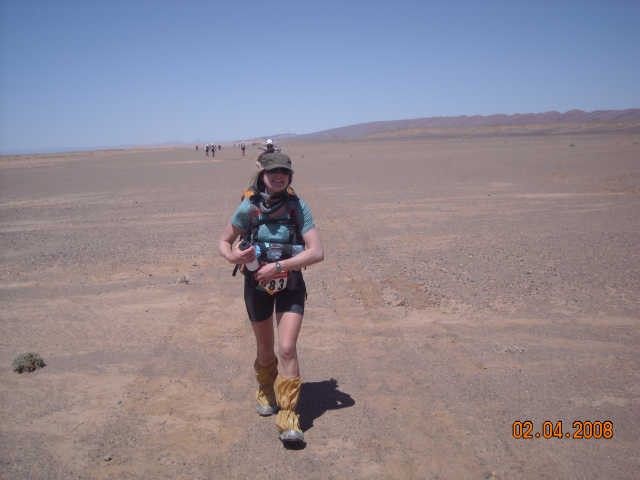The Toughest Foot Race on Earth – The Marathon des Sables
Diana Hogan-Murphy, a pharmacist from Cork living in Galway, recalls what was on the menu last week: 245 kilometres of Saharan dunes, rocky river beds, salt flats, stony valleys, steep mountain ascents, 50 degree heat, instant oats for breakfast, a day of carbohydrate gels and electrolyte powders, a freeze dried evening meal and all self sufficient. From the beginning this edition promised to be a tough one: not only was it the longest race in the 23 year history of the event but it also kicked off with Northern Africa’s highest dunes.
In brief, the Marathon des Sables comprises of running 6 stages over 7 days, the first 3 days being 110km. Day 4 is a gruelling 75.5km stretch which took Diana a respectable 14.30 hrs when she arrived back to camp just before midnight. Day 5 is a rest day for most depending on what time one arrives in from the 75.5km distance, the latest cut off being 7pm. The penultimate stage comprises of a marathon (42.2km) and the final day is a ‘fun run’ of 17.5km as one heads back into relative civilisation and the village of Tazzanine!! Initially Diana’s rucksack weighed 9.5 kg (11kg with water) which included survival equipment such as food for 7 days, a sleeping bag, compass, disinfectant, anti-venom pump, signalling mirror, distress flare, salt tablets, medicines, bandages, stove, whistle, knife and an aluminium sheet. Nine litres of water were supplied daily at various stages.
Of the 801 competitors who lined up on day 1, 10% of which were female, a total of 53 abandoned the race. With a 3 year waiting list to participate in this event, reasons would not have been due to a lack of preparation but rather a combination of the long and difficult course, harsh weather conditions and various medical afflictions. She recalls arriving daily at the medical tent where she received expert attention to her infected and blistered feet. At times the facility aptly named Doc Trotters and manned by French volunteer doctors resembled a war zone with people scattered everywhere seeking assistance and screaming in pain. To get a sense of how much bodies – feet in particular – suffered, medical teams handed out 4,2 km of elastoplasts, 13 000 compression supports and 97 litres of disinfectant. Add to that 1750 anti-diarrhoeas, 1970 anti-emetics, 3700 painkillers, 87 litres of perfusion, and 2400 litres of physiologic serum for a total of 4680 interventions!
Tent 84 where Diana shared with six others including fellow Irish doctor Alan Laverty was witness to one of the most incredible acts of human courage and sheer determination by one of their English acquaintances Andy Horseley. Laid low by gastroenteritis on the evening of day 2, his intake for the remainder of the week included an occasional liquid replacement shake. Battling to drink water without emesis, he set off each morning visibly thinner and weaker but eventually got through the finish line in 61.53 hours. Who will ever forget the moving scene as the entire camp rose in unison one morning to applaud the exit of a competitor who had to be carried by his tent mates to a waiting ambulance.
Whether eighteen or eighty years old, there is in every heart the lure of wonder, the unfailing child-like appetite of what's next, and the joy of the game of living. The Marathon des Sables is an extraordinary experience to live through. It encompasses everything from the tremendous allure of a simplistic subsistence lifestyle to the sophistication of modern technology and logistics with the race being covered by 4 Television channels and the surprise of a desert performance in the camp on the last evening by a live orchestra and soprano especially flown in from Paris. Two helicopters followed the race from beginning to end, as did 16 military trucks and an incinerator truck. With an abundance of camera crews and photographers interviewing competitors on the starting line, in jeeps throughout the race, at check points and at the finishing line, the adrenaline rush was phenomenal.
The emotions felt, the events witnessed, the friends made. Would Diana do it again? Not a chance. Would she recommend it to others? Absolutely. The pain and suffering, especially with ones feet, is intense. But pain and blisters subside and heal. Memories and friendships last a lifetime. Diana, the only Irish female competitor, finished 366th overall and was the 3rd fastest Irish out of a contingency of 11 finishing in 43.33hrs.
Donations for her charity FacingAfrica can be given through dianahogan-murphy.saharamarathon.co.uk. This organisation helps victims of Noma disease, an acute gangrenous infection affecting the face of young children caught in a vicious circle of extreme poverty and chronic malnutrition.


Well done Diana
My God Diana what an absolutely amazing achievement. Well done I am so glad you got to achieve your goal.
Congratulations
Congratulations Diana on achieve your goal it was a great achievement.
5k series
Will you be publishing a final list of entrants for the 5K series? I know a few people who have sent in entries but are not listed.
Best of luck with the series!
List of entries to 5KM
Slightly wrong article but the list of most of the entries for the 5KM are already in the 5KM thread...
OMG....ur a hardcore super
OMG....ur a hardcore super athelete....n i love ya!well done...muuuuah xxxx
One person's impact
Diana, an amazing experience that not only has deeply affected your life but also the young children in Noma charity, and as for me, your courage, perseverance and optimism have inspired us all, so thank you!
Thankful to have a friend like you. well done and congratulations again!!